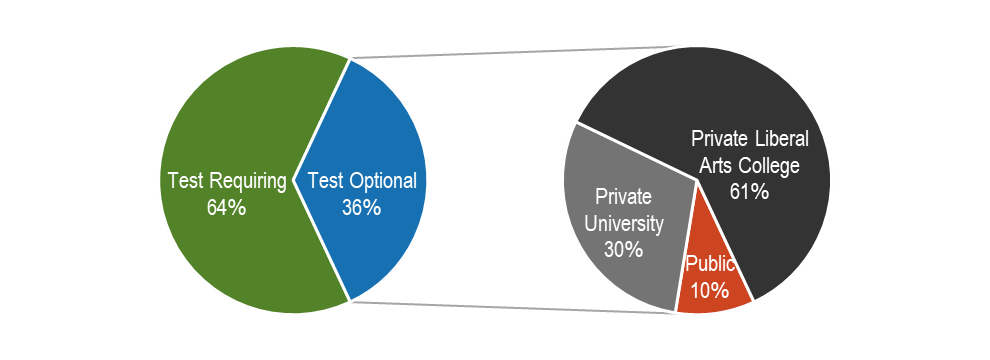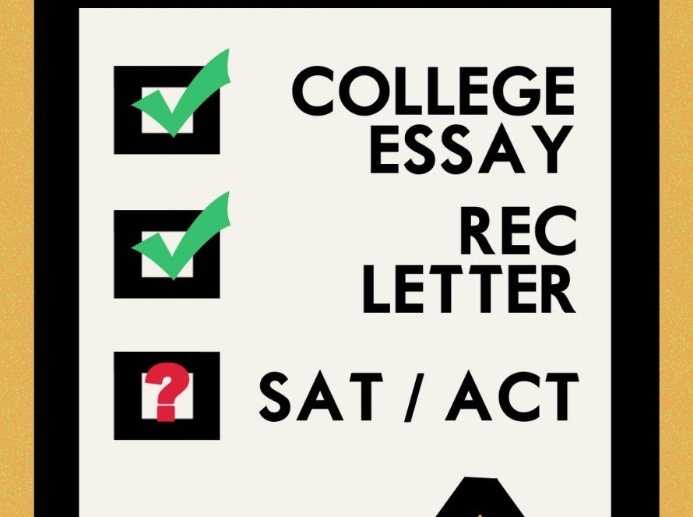The Story of “Test-Optional”
Will The “COVID Trend” End Up Sticking?

The COVID-19 pandemic has further heightened the “test-optional” movement.
May 25, 2022
The college search is difficult enough without a global pandemic getting in the way. From searching to touring to applying to choosing, gearing up for college is hard. Now, thanks to COVID, the entire process has often been flipped upside down for high school juniors and seniors, forcing students to adapt to new changes relating to campus tours and application deadlines, amongst other things.
For the high school class of 2021 in particular, touring campuses was often not possible, and, for many students, visiting schools plays a huge role in choosing where to apply, and eventually, selecting the right school.
Another issue? Standardized testing. Many prospective college students across the country have been unable to take the SAT or ACT because of the pandemic. For many colleges and universities in past years, standardized test scores have been used as part of the application process. However, COVID has forced the majority of colleges and universities to enact a “test optional” policy if they hadn’t already. For many schools, students do not need to send test scores as part of their application through the fall of 2023 application cycle. According to College Board, “[the test optional policy] doesn’t mean that schools aren’t interested in seeing all applicants’ test scores—but if a student doesn’t submit their scores, it won’t be counted against them in the application review.”
While some schools are testing out the test optional policy for the first time, there are others that have been test optional for decades. Bowdoin College declared itself a test optional institution in 1969, making it the first test optional school in the United States. Bowdoin and other test optional institutions stress that if a student wants to submit their test scores, they will be taken into consideration when reviewing their applications, but if a student decides not to submit their scores, their candidacy will not be impacted.

Other liberal arts colleges followed Bowdoin’s lead, such as Bates College and Colby College. Now, many more colleges and universities are discovering the benefits of a test optional policy. Schools that are test optional can better foster diversity and hunt down bright and capable students who simply are not strong test takers. Forty-four percent of the Bowdoin College class of 2025 did not submit test scores. Middlebury College enacted its pilot test optional policy at the start of the pandemic, and fifty percent of their class of 2025 did not submit test scores.
What is even more shocking is the fact that schools outside of the liberal arts category are testing out the test-optional policy. The University of California schools have suspended their standardized testing requirements until 2024. Harvard University and Cornell University suspended their standardized testing requirements back in 2020, when the pandemic shut down testing sites. According to bestcolleges.com, “Almost 80% of baccalaureate-granting institutions don’t require tests. That list includes more than 90% of schools ranked among U.S. News & World Report’s top 100 national universities and national liberal arts colleges.” Some colleges and universities have even gone as far as becoming test-blind, meaning test scores will not be considered for admission even if submitted.
According to data from Common App, for the 2021 application cycle, 51% of students submitted test scores with their college applications. That is a large decrease from the 78% of students who submitted test scores in 2019. FairTest director Bob Schaffer also stated that test-optional policies can help make colleges and universities more diverse, saying that test-optional colleges in 2021 had larger, more academically sound, and more diverse applicant pools.

The big question, however, is whether submitting test scores is a major factor in getting admitted to a college or university. According to CollegeRaptor, while so many institutions have implemented a test-optional policy, test scores still matter, because admissions officers are looking to see if an applicant’s test scores match the grades received in class. On the other end of the spectrum, Devin Barricklow of CollegeVine argues that test scores “are not the only thing that matters on your application.” Bowdoin College has for decades stressed its ability to evaluate applicants without test scores, relying more on a student’s academic transcript, extracurricular activities, and letters of recommendation. Now, it seems like a lot of institutions are becoming more in tune with the test-optional mentality.
As COVID-19 becomes more manageable and life returns to a new version of normal, what will happen to the test-optional policy? One Ivy League admissions director stated that “It has been really illuminating and instructive to be frankly kind of forced into [the] policy” thanks to the pandemic. While many institutions have found benefits from enacting a test-optional policy, some will be returning to a test-required policy. In March of 2022, MIT announced that the institution will be reinstating its standardized testing requirements in order to help its admissions officers discover strong students whose transcripts have been impacted by the pandemic.
However, by 2026, the SAT and ACT might not even be around, because so many colleges and universities have discovered that the test-optional policy, while different and somewhat new, has worked just fine in the college admissions world. Institutions have received record-high numbers of applications. Applicant pools are becoming more diverse. Students are using the test-optional policy as a reason to apply to institutions they feel they wouldn’t have been able to apply to before the policy was enacted. Finally, test-optional policies have not led to a decrease in student success and performance at certain institutions.

With over 1,000 institutions having adopted some sort of test-optional policy, Bowdoin College must be feeling very proud that the movement they helped start back in the 1960s is influencing students positively and showing other institutions that there are more ways to discover strong applicants than just looking at performance on a three hour test.






